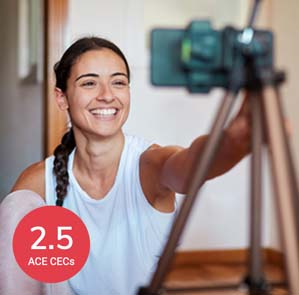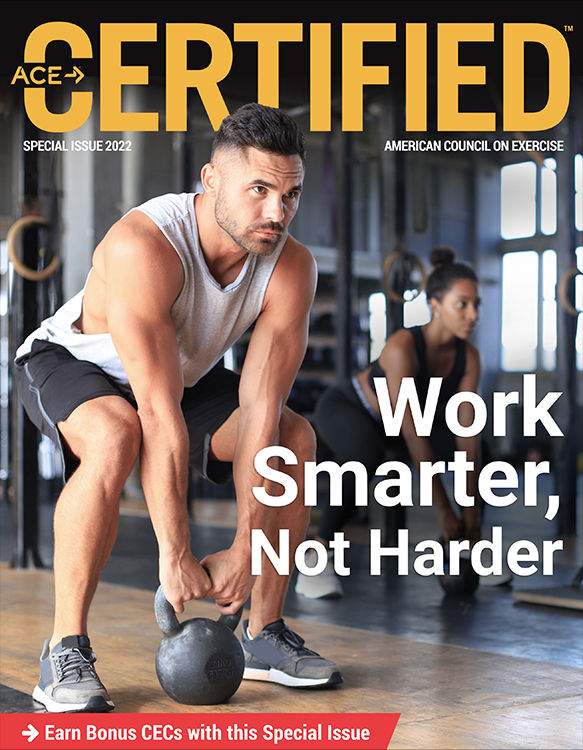
In the world of frequently asked health-coaching how-to questions, “How do I structure an effective coaching session?” tops the list. Unfortunately, there isn’t a simple, straightforward answer. While this may seem defeating or even frustrating, creating great sessions isn’t about following a template and checking every box; it’s about the connections you make with your clients each time you interact in the partnership you both created.
Every health coach has a unique approach rooted in the scientific principles that guide their practice. Discovering your unique approach is one of the most fun (albeit challenging) aspects of professional development and growth. Like your professional philosophy, your structure will likely change as you gain more experience and insight. For now, instead of focusing on the structure, focus on the flow of a session and do what is authentic and natural as the conversation unfolds.
What is a Coaching Session About?
Before venturing too far into a closer examination of the “flow” of a session, let’s first address what a session is and discuss what a session isn’t or doesn’t have to look like. As practiced health coaches will share, myself included, we often feel the need to “do all the right things,” but effective coaching isn’t about that. Much like behavior change, it’s mostly about a thoughtful and engaging process.
A session is about…
- Engaging in a guided conversation and partnership
- Listening, not talking (on the coach’s end)
- Meeting clients where they are
- Creating a supportive environment where clients can do their best work
- Discovering a client’s strengths
- Unlocking the client’s potential
A session is NOT about…
- Providing a rigid structure
- Directing a specific action plan to the client
- Engaging in constant verbal exchange; silence is necessary and valuable
- Diagnosing problems or health concerns
- Dispensing advice or information
- Using your knowledge to provide the “right answers” to the client
Developing Flow
It’s important to recognize that an initial coaching session will look and feel different than subsequent sessions; this is normal, expected and intentional. If you are meeting a client for the first time, keep the following considerations in mind:
Logistics
- Where is the session taking place?
- Did this client come to you on their own or through a referral?
- Be aware of appointment management and scheduling sufficient time between clients.
- Will you contact the client prior to the session?
- Will you provide clients with a welcome packet? If yes, where can they find it or how can they obtain a copy?
Setting a foundation conducive for collaboration and rapport
- Develop warm and engaging greeting and introductions.
- Consider all aspects of professionalism, including your attire, body language, enthusiasm and rapport-building efforts.
Outlining a plan for the partnership you will create with your client
- What does the coaching agreement look like and entail?
- Be sure to clarify any other policies and procedures you might have.
Facilitating exploration and client assessment
- What information will you gather? What forms will you implement?
Concluding the session
- How will you document the session?
- Summarize the session and discuss next steps with the client.
- Schedule the date and time of your next session.
The initial welcome session will likely last longer than subsequent sessions. Before meeting with a client for the first time, it is helpful to have a structure for how the first session will go and what “must-haves” are included in that structure. For example, in summarizing a session, it is useful to have a form for documenting measurements (if any were taken), goal statements, client to-dos or tasks (homework), your to-dos or tasks, and a client accountability process. (Note: ACE Certified Professionals can access a Health Coach Visit Summary Form at the link at the top of this page.) I also like to bookend a session by asking my clients two questions:
- “How do you feel about the work you did here today?”
- “What is one thing you’re wondering about right now?”
Again, you will find your own rhythm as time and experience unfold.
Tips From the Pros on Structuring Coaching Sessions
Our field is rich with experience, insight and guidance. Practiced health coaches share their insights for how to develop and provide flow to a session so that each session is meaningful and effective. You will find that each professional interviewed here offers a unique perspective, thus reinforcing the earlier point that there’s no single “right” way to accomplish the goal.
Erin Litton, MA, MCHES, ACSM-CEP, lecturer and practicing health coach, suggests that health coaches develop a loose script, which will allow them to spend their energy listening instead of ruminating over what question to ask next. “Create pocket questions,” urges Litton. “It’s important to know what questions are authentic to you, as the coach, and have them prepared. Avoid spending energy thinking about what to ask or how. Instead, be present, use active listening skills and offer reflection. This way, you take the pressure off yourself to know the next step.”
In other words, “know your flow” and what is authentic to you. “When a coach knows their flow, there’s an element of comfort you experience,” explains Litton. “Coaching is about giving someone the space to navigate their answers to their pain points; it’s not about asking a specific question. Ultimately, it’s the clients’ response that matters—not your question.”
While there are many open-ended questions health coaches can rely on, Miller and Rollnick, the creators of motivational interviewing, highlight these five “go-to” options:
- Why would you want to make this change?
- How might you go about it in order to succeed?
- What are the three best reasons for you to do it?
- How important is it for you to make this change, and why?
Once you receive answers to these four questions, reflect, summarize and ask:
5. What do you think you will do?
Meg Root, NBC-HWC, is a senior wellness coach and health coach mentor. She builds on Litton’s perspective and offers this insight in structuring coaching sessions: “Each session, even with the same client, will look and feel different, and that’s O.K.”
Root emphasizes how coaches can open a session. “You need a horizon or focus. Starting the session off well with a positive coaching question or statement is powerful. I like to use statements or questions such as, ‘Tell me what your biggest win is this week’ or ‘What did you discover this week in working toward your goals?’ Framing the opening of the session in this way helps us focus on the positive versus getting caught up in the quagmire that is created from naturally negative thinking. It gets the client (and the coach) thinking about possibilities.” When the client’s mind is positive, it is open to change and open to reflection. Root continues: “As coaches, we want to position our clients to tell positive stories about their lives.”
Following the opening conversation, spend some time checking in with your client about their goals. Root encourages using language such as, “Last week you said you were going to do X, Y and Z. How are you feeling about this progress?” During this time, reflect upon and discuss values, importance and reasons for change. This moment, explains Root, is not the time to “focus on the small micro details or granular aspects, as doing so doesn’t get to the core energy or the importance of change to the client.” As you listen to the client, watch for sustain versus change talk. “As a coach, we need to be ready to soften sustain talk and strengthen change talk.”
Root also provides tips for closing the session and reminds health coaches that summaries are not just about saying everything that you and your client discussed. “Imagine creating a bouquet for your client,” urges Root. “Pick the best ‘flowers’ or parts of the conversation that are the most powerful. Include strengths, values and affirmations and present this bouquet to the client.” Here’s an example: “It sounds like cooking meals is going to be your big focus for the week, and meal planning specifically. Based on X, Y and Z, these actions sound the most important to you. You mentioned you enjoy cooking, and you have the skills to make delicious and nutritious meals.” Approaching the closing or end of a session in this manner sets clients off with hope and a plan (a set of actions to focus on).
Bookend the session by asking for nuggets of wisdom the client gleaned from the work they did with you. Ask questions such as, “What resonated with you the most from your work today? or “What tools are you walking away with today?” Encourage clients to voice the takeaways that are important to them. Note them for the next session and use them in your opening.
Be Aware of Potential Traps
While both Litton and Root offer great advice regarding the important elements to include in a coaching session, they each encouraged avoiding specific “traps” or missteps they weren’t aware of when they first started their respective practices.
“Sitting in silence can feel awkward,” notes Litton. “But coaches should learn to be comfortable in silence. Sit with the client in that space. “Overtalking or overexplaining can reduce connection. Give yourself permission to be silent and speak less.”
Litton also reminds coaches to avoid doing more work than the client. “Your energy is going to be drained if you place the burden of change on you. The client must be the one to change. It’s about being there, sitting with them and letting them talk through that difficult space and the difficult nature of change.”
Root expands on the potential traps coaches can fall into as she recalls her own early struggle of starting sessions effectively. “The opening of a session is critical,” she says. “It’s tempting to start by asking ‘How are you?’ but this doesn’t get to the focus or the agenda effectively. Instead, what you do is open Pandora’s box, and the session can spiral into a lengthy, unfocused discussion about a wide range of topics that may not have anything to do with the client’s intended goal. Sessions then become focused on the topic de jour. This throws the client and the coach off task.” If this happens, Root suggests redirecting the client back to the main topic by asking, “Is this something you want to talk about today?” This gives you an opportunity to gently remind the client of their goals and establish a focus in the first third of the session.
The second word of caution Root highlights is the use of the word “accountability.”
“In the minds of many, accountability carries a negative or alienating feeling,” says Root. “Coaches can avoid this fear-associated word by framing the question as, ‘How do you plan to follow through with the action plan you established today?’ This way, clients are directed to identify ways in which they will track progress and note any stumbling blocks. “Accountability is then framed in a more positive, solution-oriented manner.”
Session Must-have Elements
In conversation with Litton and Root, obvious themes developed. Both emphasize the relationship coaches need to have with their clients, and the value of revisiting goals and identifying a session agenda in the first few minutes. They also emphasized the collaborative nature of a session; the intention is to partner in identifying strategies and formulating an action plan. Lastly, there are no specific templates coaches need to follow, but specific elements are, to a degree, necessary for building effective sessions and client interactions. Remember, it’s about establishing a flow and an intention.
Reflect on the sessions you have and evaluate whether the following elements are present. If one or more is missing, consider how you can revise your approach to elevate the session’s quality and outcome.
- Establish rapport (if it’s a new client) or build upon the existing client–coach relationship.
- Use the first third of the session to follow up on last week’s progress and how self-monitoring practices are going. Revisit client goals, values and importance.
- Identify the session agenda or topic.
- When necessary, reframe a client’s challenges and work together to identify a solution or strategy to address them.
- Strengthen change talk (soften sustain talk).
- Summarize the session and formulate an action plan (this is where you present the “bouquet”).
Remember the Basics
Coach Meg Moore, CEO and Founder of Wellcoaches, offers rich wisdom in her “remember the basics” approach. Through this strategy, Moore hopes to encourage other coaches to avoid overcomplicating the coaching process and the interactions you have with clients. Her tips include:
- Be present. Step into all-in awareness. Your mind is clear and clean of self-oriented concerns. Clients should feel your natural state of benevolence, which creates trust and a sense of safety to open up about their narratives, strengths, challenges and opportunities.
- Hold space. Often, when we are in our expert modes and we give suggestions or advice, we fill the space. In coaching, we are creating and holding space for our clients to pause, reflect and shift into a curious state of self-discovery.
- Spot strengths. Be quick to notice and share your observations about your client’s strengths and resources, and then unpack your client’s experiences of what’s working well and how that might be valuable.
- Notice growth edges. A client’s growth edge is wherever they have tension, edginess or feel stuck, a sign that they are in a mindset that isn’t serving their path toward well-being. Be compassionate and playful when reflecting (with permission) that you are noticing a potential growth edge, which is a growth opportunity. “Would you like to explore and generate new perspectives?”
- Go nonlinear. Ask your client to pick a random thing (e.g., a favorite wild animal, something on a shelf or a character strength from a list of strengths). Invite them to let their mind wander, connecting the random thing with a brand-new idea to navigate around an obstacle. Watch their face light up when a new idea arrives.
Behavior change is complex and involves an artful combination of strategies and tactics. Overcomplicating the process can distract coaches from what really matters: the client experience. Keep the basics at the forefront of your attention as you work thoughtfully alongside your clients to guide them in meaningful ways.
The Take Home
Litton and Root remind professionals to rely on a professional community. Engage with your organization’s members and stay connected to trends and available data. “Being an engaged professional and being connected with your community helps support your skill development and elevates your coaching practice,” says Litton.
Root drives home the value of open-ended questions and using those to your advantage. “Practice asking open-ended questions in your daily interactions with others,” she urges, “not just with your clients. Make this your habit.”
The structure of a session is as unique to the client as it is to the coach. The “flow” and structure will evolve over time—much like the process of change. Focus on developing relationships with your clients, gaining trust and collaborating on meaningful goals and the conversation that grows out of your client’s pursuit of those goals. The structure is much less important than the overall experience you give your clients.
Expand Your Knowledge
 |
Expand your services with a flexible framework for growing a successful online training business.
|
 |
Enhance your practical, in-demand skills in behavior change coaching through a comprehensive virtual learning experience.
|
 |
Learn specific strategies for creating the best motivational environment for clients to be successful and achieve their behavior change goals.
|





 by
by 





